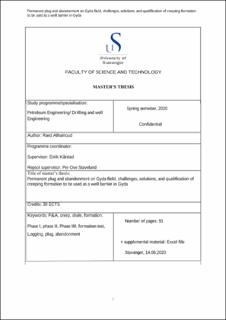| dc.description.abstract | Well plugging and abandonment (P&A) presents a very substantial challenge to oil and gas operators, and this challenge will increase exponentially in the coming decades. P&A operation cost the operators billions of dollars without any return in investment.
Every well needs a unique program to plug it, that depends on the construction design, type of well and depth. Many challenges appear during the operation, as restricted access to the desired depth due to the scale deposits, casing collapse and other obstruction. In Gyda field many wells suffer from scale in the production tubing that required remedial operation to remove the scale and get access in order to set the deepest plug and cut the tubing.
P&A is divided into three phases: phase I (wireline phase) where it is conducted from the BOP deck to check well accessibility, cut the tubing and install a double well barrier to remove XMT and install BOP. Phase II is conducted from the drill floor using the rig, where the main and heavy operation is performed as pulling the production tubing and casing, install cement plugs, perform PWC or formation test. Phase III (decommissioning phase) is performed after phase II, which is conducted by cut and remove conductor and wellhead.
To permanently plug and abandon a well, a cross sectional barrier must be formed. In some wells, there is no cement behind the casing at the desired depth to install a barrier. In this case annular barrier must be established to get a cross sectional barrier. This means heavy and costly remedial operation is needed to establish the annular barrier as PWC or casing milling.
In some wells, logging showed good bonding between formation and casing above the theoretical top of cement, and formation communication pressure test verified it, the only justification behind that is the formation deformation where the formation moved toward the annular space and seal it off.
To qualify a formation as an annular barrier, two conditions must be fulfilled, the formation must have an enough strength to withstand the future reservoir pressure and the bonding between casing and formation must provide a hydraulic isolation. In Gyda field, the lower Hordaland formation (Creeping formation) was tested and qualified as an annular barrier. | en_US |
